#the emperor of the North Pole
Explore tagged Tumblr posts
Text
The happiest of birthdays in the afterlife to Lee Marvin! Truly one of the best to ever do it!




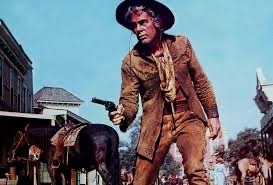
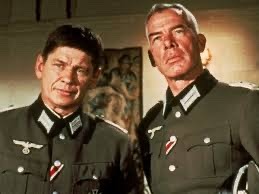
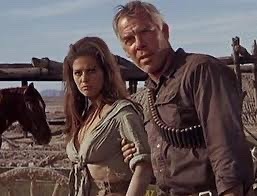
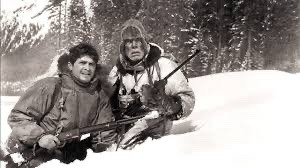
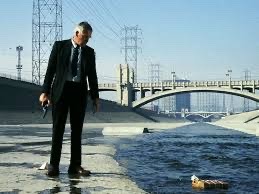
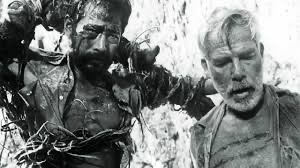
#Lee Marvin#point blank#the dirty dozen#hell in the pacific#death hunt#Gorky park#the delta force#I the wild one#the big heat#cat ballou#the killers#the big red one#the professionls#avalanche express#prime cut#the man who shot liberty valance#Monte Walsh#the emperor of the North Pole
4 notes
·
View notes
Text
Film Journal
"Emperor of the North" by Robert Aldrich

0 notes
Text

How Hadrian’s Wall is Revealing a Hidden Side of Roman History
A party invitation. A broken flipflop. A wig. Letters of complaint about road conditions, and an urgent request for more beer.
It sounds like the aftermath of a successful spring break, but these items are nearly 2,000 years old.
They’re just some of the finds from Hadrian’s Wall – the 73-mile stone wall built as the northwestern boundary of the Roman Empire, sealing off Britannia (modern-day England and Wales) from Caledonia (essentially today’s Scotland).
While most of us think of Pompeii and Herculaneum if we’re thinking of everyday objects preserved from ancient Rome, this outpost in the wild north of the empire is home to some of the most extraordinary finds.
“It’s a very dramatic stamp on the countryside – there’s nothing more redolent of saying you’re entering the Roman empire than seeing that structure,” says Richard Abdy, lead curator of the British Museum’s current exhibition, Legion, which spotlights the everyday life of Roman soldiers, showcasing many finds from Hadrian’s Wall in the process. A tenth of the Roman army was based in Britain, and that makes the wall a great source of military material, he says.
But it’s not all about the soldiers, as excavations are showing.
A multicultural melting pot
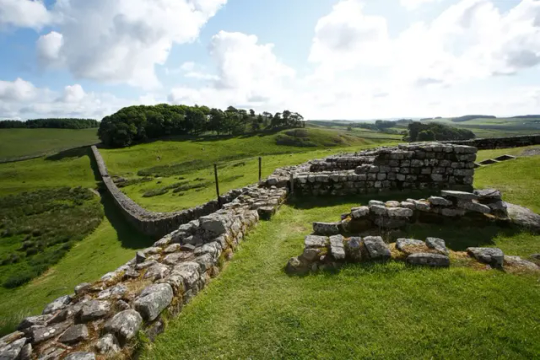
Hadrian, who ordered the wall to be built in 122CE after a visit to Britannia, had a different vision of empire than his predecessors, says Frances McIntosh, curator for English Heritage’s 34 sites along Hadrian’s Wall.
“All the emperors before him were about expanding the empire, but Hadrian was known as the consolidator,” she says. He relinquished some of the territory acquired by his predecessor Trajan, and “decided to set the borders” – literally, in some cases, with wooden poles at sites in Germany, or with stone in Britannia. Where those poles rotted thousands of years ago, the wall is still standing: “A great visual reminder” of the Roman empire, says McIntosh.
It’s not just a wall. There’s a castle every mile along, and turrets at every third-of-a-mile point, with ditches and banks both north and south. “You can imagine the kind of impact that would have had, not just on the landscape but on the people living in the area,” says McIntosh.
And thanks to the finds from the wall, we know a surprising amount about those people.
Although historians have long thought of army outposts as remote, male-dominant places, the excavations along the wall show that’s not the case. Not only were soldiers accompanied by their families, but civilians would settle around the settlements to do business. “ You can almost see Housesteads as a garrison town,” says McIntosh. “There were places you could go for a drink and so on.”
The Roman rule of thumb was not to post soldiers in the place they came from, because of the risk of rebellion. That meant Hadrian’s Wall was a cultural melting point, with cohorts from modern-day Netherlands, Spain, Romania, Algeria, Iraq, Syria – and more. “It was possibly more multicultural because it was a focus point,” says McIntosh, who says that the surrounding community might have included traders from across the empire.
Soldiers were split into two groups. Legionaries were Roman citizens from Italy, who had more rights than other soldiers and imported olive oil, wine and garum (a sauce made from decomposing fish).
They worked alongside auxiliaries – soldiers from conquered provinces, who had fewer rights, but could usually acquire citizenship after 25 years of service.
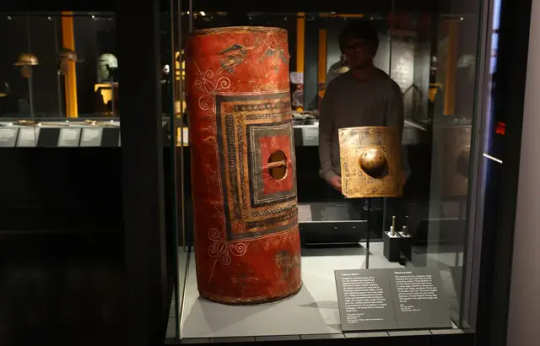
Soldiers carved their names and regiments on stones to show which part of the wall they built – around 50 of them are on display at Chesters fort.
But the wall shows that women and children were equally present.
McIntosh says that pottery brought to the camps – from the Low Countries and North Africa – shows that the soldiers “brought their families, who cooked in traditional style.” Archaeologists have found what seems to be an ancient tagine for North African-style cooking.
A tombstone from Arbeia fort for a woman named Regina shows she was a freed slave from southern Britain who was bought by – and married to – a Syrian soldier.
Another woman buried at Birdoswald fort was laid to rest with chainmail that appears to be from modern-day Poland. “Perhaps she married someone in the army,” says McIntosh, who calls the wall a “melting pot of people from all over the world under the banner of the army.”
“They brought their own religions, as well as worshipping Roman gods and adopting local deities,” she adds. At Carrawburgh, a temple to Mithras – an originally Persian deity – sat near a spring with a shrine to a local water spirit.
‘Wretched little Brits’

Some of the most extraordinary finds from the Roman empire are coming from one site on Hadrian’s Wall: Vindolanda. Here, archaeologists have found a wealth of organic remains because of what curator Barbara Birley calls the “unusual conditions onsite.”
At Vindolanda there are the remains of at least nine forts over 14 levels. “When the Romans would leave, they would knock down timber forts, and cover the area with turf and clay, sealing the layers underneath,” she says.
“Because it happened so many times, the bottom five or six layers are sealed in anaerobic conditions, so things don’t decay. When we get down there, we get wooden objects, textiles, anything organic.”
Vindolanda has the largest collection of Roman textiles from a single site in western Europe, as well as the largest leather collection of any site in the Roman empire – including 5,000 shoes, and even a broken leather flip-flop. “We probably had a population of 3,000 to 6,000 depending on the period, so 5,000 is a lot,” says Birley. For Abdy, the shoes evoke the conditions of the wet borderlands. “Women’s and children’s shoes are hobnailed – you needed it in the mucky frontier dirt tracks. They’re very evocative.”
There’s even a wig made from a local plant, hair moss, which is said to repel midges – the scourge of Scotland during the summer. A centurion’s helmet is also crested with hairmoss – the ancient equivalent of spraying yourself with insect repellent.
The first woman to write in Latin
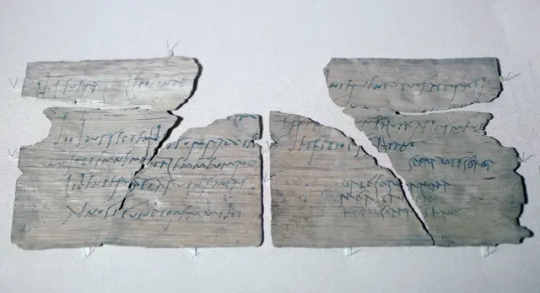
One of the most famous finds is the trove of wooden writing tablets – the largest found anywhere.
“They give a snapshot of what life was actually like,” says Birley. “We understand so much more from written correspondence than from ‘stuff,’ and, archaeologically, it’s the stuff that usually survives – things like metals and ceramics.
“These were written in ink, not on a wax stylus tablet, and we believe they were used for what we’d put in emails: ‘The roads are awful,’ ‘The soldiers need more beer.’ Everyday business.”
The tablets – or “personal letters” as Birley describes them – were found on the site of a bonfire when the ninth cohort of Batavians (in the modern-day Netherlands) were told to move on.
“They had a huge bonfire and lots of letters were chucked in the fire. Some have been singed – we think it may have rained,” she says. One of them calls the locals “Britunculi” – “wretched little Brits.” Another talks about an outbreak of pinkeye. One claims that the roads are too bad to send wagons; another laments that the soldiers have run out of beer.

Among the 1,700 letters are 20 that mention a woman called Sulpicia Lepidina. She was the wife of the commander of the garrison, and seems to have played a crucial role. There’s a letter to her from another woman, Paterna, agreeing to send her two medicines, one a fever cure.
Birley says it’s similar to today. “If you’re a group of moms, still today we say, ‘Do you have the Calpol?’ It’s very human.” For Abdy, it’s a sign that women were traders. “She’s clearly flogging her medicines,” he says. “It’s really great stuff.”
Another tablet is an invite from Claudia Severa, the wife of another commander at a nearby camp. It’s an invitation to a birthday party. Under the formal invitation, presumably written by a scribe, is a scrawl in another hand: “I shall expect you, sister. Farewell, sister, my dearest soul.”
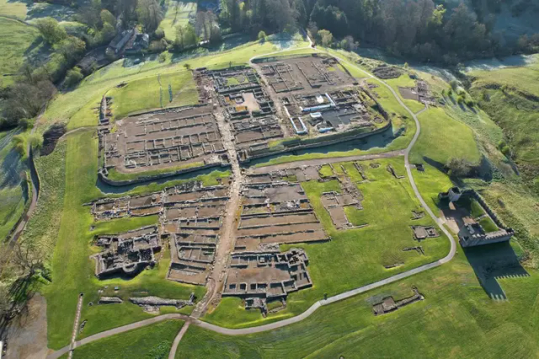
Presumably written by Claudia herself, it is thought to be the earliest example of a woman’s handwriting in Latin.
Without the organic finds – the shoes and the letters that indisputably belonged to women, unlike jewellery or weaving equipment – it’s difficult to prove conclusively that women lived in significant numbers. Vindolanda “illustrate the missing gaps,” says Abdy. For Birley, they prove that women were as crucial a part of army communities as men. “Before the Lepidina tablets were found we didn’t really understand the interactions between the soldiers and their wives,” she says. Another tablet is written by what is thought to be a Spanish standard-bearer’s common-law wife, ordering military equipment for her partner.
“The Vindolanda collection is showing that there weren’t just camp followers and prostitutes; women were part of everyday life, and contributing to the military community in many ways,” says Birley.
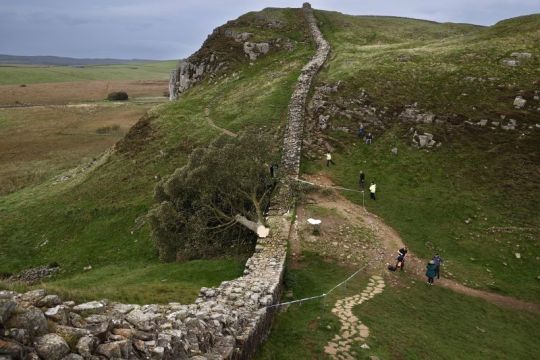

Abdy says that Hadrian’s Wall is interesting because the resident women span “all classes of society,” from Regina – the dead freedwoman, who would have been “bottom of the heap” – to the trader Paterna and the noblewoman Lepidina.
And of course, there’s the wall itself.
“In the Netherlands and Germany the finds are often stunning and better preserved – you go to museums and are bowled over. But in terms of structural remains, Hadrian’s Wall must be among the best,” says McIntosh, modestly, of her site.
Abdy agrees: “I can’t think of many symbols so redolent of imperial will than that wall.”
By Julia Buckley.
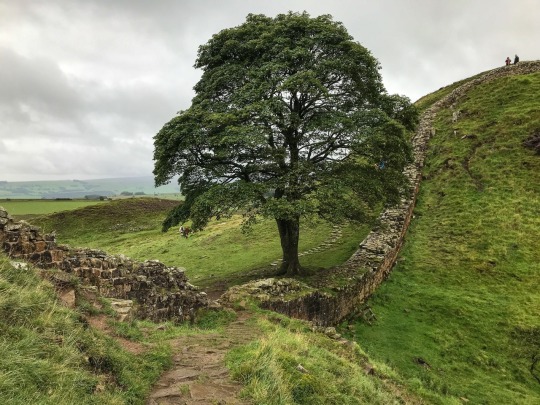
#How Hadrian’s Wall is Revealing a Hidden Side of Roman History#Hadrian’s Wall#emperor hadrian#northwestern boundary of the Roman Empire#Britannia#Caledonia#roman legions#ancient artifacts#archeology#archeolgst#history#history news#ancient history#ancient culture#ancient civilizations#roman history#roman empire#long post#long reads
911 notes
·
View notes
Text
Dragon Ball Z/Super: Comparing and contrasting Goku and Zamasu— two sides of the same coin? (Long post full of yapping!)
The Goku Black arc consistently portrays Black/Zamasu to be ideological parallels to Trunks for obvious reasons (Hope vs Despair, Selfishness vs Selflessness, he's the protagonist of this arc, etc.), but I think it's an interesting exercise to compare Zamasu's journey to Goku's. In my opinion, it really hammers in why Zamasu failed to reach enlightenment and fell from grace besides "mortals = stupid and barbaric" and plain old narcissism.


Everyone knows Goku's story by now, but I want to hone in on the part that I believe Zamasu's own parallels.
The beginning of Z features Goku gradually being introduced to entirely new realms of power and scale. He has to team up with the guy he worked his ass off to defeat 5 years ago just to barely defeat Raditz, a mid class Saiyan, sacrificing his own life in the process.

He is informed constantly by Vegeta that he is nothing but low-class scum, born at the bottom of the interplanetary Saiyan "totem pole", compared to Vegeta's own super-elite-royalty-goodness.

Then, by Namek, he manages to surpass Vegeta, and even trounces the emperor of the universe who subjugated the entire Saiyan race. After Namek, Goku grows so much that the conceptions of "class" that he was blindsided by quickly become faint memories, only brief blips in his life's work to always get stronger.
Not to be the strongest, or even to become "the strongest Saiyan who ever lived", simply to get stronger. Goku's goal is forever ongoing; he will never feel as if his duty is complete. If it ever was, he'd be restless and unsatisfied.
The key thread throughout the Saiyan and Frieza Sagas is that Goku never uses the labels ascribed to him or his opponents as anything more than momentary benchmarks in service of his overarching, everlasting goal to achieve more and more strength. He does not hear Vegeta's boasts about his status and go "okay, guess I'll be good enough once I can beat Vegeta in a 1 on 1, since I'll basically be a super elite!". He hears King Kai's fervent warnings about Frieza's terrible strength and gets curious rather than demotivated.


He doesn't use either of these as an excuse to run away or quit training.

In fact, Goku never uses anything as an excuse. He is not married to any sort of arbitrary benchmark of strength (that honor goes to Chi Chi), even in Super as he gains power that rivals Gods of Destruction.
To treat a level of strength, or a class (God of Destruction, Angel, Super Elite, Emperor of the Universe) as a stopping point for Goku or some sort of ultimate goal would imply that Goku's desire for strength has a defined end. But it doesn't, and so Goku doesn't put much stock into those things. He never loses sight of his goal, and he literally doesn't even stop training when he's dead.

As for Zamasu, the beginning of his journey is why I thought to juxtapose him with Goku in the first place. He shares a surprising similarity with early Z Goku, in that both were able to achieve greater statuses than their birth would afford them.
Zamasu started off as a normal Kai, the guardian of a universal quadrant (the North, same as King Kai). In terms of Dragon Ball's divine hierarchy, this is actually quite the low standing. It is the second lowest known class of Gods, only ranking above planetary deities like Kami and Dende. If a Core Person (Kai race) is born from a rare, special golden fruit, only then will they be qualified enough to train to be a Supreme Kai.
Zamasu is the only known canon example of a normal Kai being selected to become a Supreme Kai, and so his exceptional ascension up the divine hierarchy is a natural parallel to Goku's own defiance of his low-class nature and his comparatively low power level at birth.

Unlike Goku, however, Zamasu is absolutely obsessed with and bound by certain labels, which ultimately leads to his ideological downfall.
Firstly, we can see his fixation on the idea of godhood when he speaks to Gowasu.


When Gowasu simply tells him to temper himself and observe mortals, he immediately begins focusing on and belittling the gods' philosophy, almost outright saying "what the gods think does NOT align with justice". The way he phrases these sentences in both the dub and sub is key: he says "I thought you'd teach me justice, but...", which creates a juxtaposition between "divinity" and "REAL justice".

He even begins to doubt that a god could be considered a god if they did not align with his definition of justice.
Zamasu is young and inexperienced for a Kai (especially considering regular Kais have far shorter biological lifespans than Supreme Kais), so the reactions he displays in this scene suggest that he had a very romanticized, linear view of both godhood and justice. When Gowasu's statement suggests to Zamasu that he can't reconcile the two, it basically calls out all that Zamasu currently stands for, and he doesn't take it well.


Gowasu ends the discussion by challenging Zamasu's narrowminded belief that gods are "absolute" and perfect, but by then the two are already unable to get through to one another.
If you look at the other gods in Dragon Ball, you'll see what Gowasu means here. For example, Beerus is lazy, temperamental, and childish; none of the other gods really like him. Elder Kai is a lecher. Champa is rather undignified and just as temperamental as Beerus.



Where Goku seeks strength, Zamasu seeks virtue. Yet, unlike Goku, Zamasu has an arbitrary benchmark at where his objective stops: the abstract concept of "godhood".
When Zamasu reaches that endpoint and finds that it's not all it's cracked up to be, he constantly contorts his definition of divinity to match it— or rather, to match himself— rather than accepting that being a god is not equivalent to having a "perfect" sense of justice, or being "perfect" in general. He commits barbaric, brutal, bloodthirsty, and wanton acts, all in the name of "divine justice", despite those things being less becoming of gods and more becoming of mortals.



The dilemma extends to the very end of the arc, where in the dub Corrupted Merged Zamasu says to Vegetto: "If one can't control a world, one can't be called a god of it", instantly justifying his hypocrisy, his sadism, his violence, and his arrogance instead of looking inward and asking himself what it meant to be a god.
Like Gowasu said, Zamasu was "obsessed with the contradictions of gods and mortals", and as Trunks said, "it isn't about gods or mortals". Zamasu was so enamored with the idea and label of godhood, yet did not question whether or not his values, the values of his future counterpart, or the values of the other gods aligned with it. And how could he have questioned it if he didn't truly know what godhood meant himself— if he just used the idea as a synonym for what he believed?

Where Goku saw arbitrary labels as inconsequential to his overarching quest, Zamasu saw his life be entirely dictated by them. Zamasu allowed himself to be entrenched in the god-mortal dichotomy, whereas Goku's nature would never allow him to lose his big-picture goal like that.
When Goku's reality is challenged, whether by the introduction of some groundless measure of value (power level, Saiyan class) or by a vastly stronger opponent, he doesn't flinch. He doesn't stop. He doesn't make excuses. His overall goal doesn't change.
When Zamasu's reality was challenged, he broke and became everything he hated. He bent and twisted the rules of what he considered "just", and shattered the natural divine order by doing away with all Gods of Destruction. His goal, by then, was unrecognizable compared to his previous goal to be a benevolent Supreme Kai.
Where Goku's triumphs led him to continue being diligent and humble, Zamasu's own led him to be stagnant and arrogant. Even though Zamasu was proactive and cunning, he was stagnant in the sense that none of what he did made him more moral or virtuous, or gave him a greater understanding of the universe, even though those were the things he originally sought when studying under Gowasu.
All he did was further embed himself (literally, with Future Zamasu) within his own radical beliefs; he never progressed towards his original goal because he replaced it with "I am THE God, no more gods are needed, I will exterminate all mortals personally". His arrogance and inability to see gods as flawed beings made him lose the plot.
Goku continued working hard and getting stronger after vanquishing Frieza, whereas Zamasu's entitlement made him become a complete shell of himself.
Goku saw his growth from low-class warrior to Legendary Super Saiyan to be a testament to everything he stood for; the desire to protect and avenge his friends, his inherited Saiyan pride from Vegeta, and most importantly, his neverending journey to get stronger. Zamasu saw his ascension from North Kai to Supreme Kai as an excuse. A stopping point. An "okay, I've reached the pinnacle of the virtue I seek", refusing to accept that there was more beyond the arbitrary value and moral standing he placed on the role of a god, refusing to think mortals could ever possibly learn, and refusing to think gods could ever need to learn.

Zamasu is a dark reflection of Goku— Son Goku is everything that Zamasu is not. Zamasu is the opposite of many reasons that Goku is such a distinct and unique character, and that makes both of them all the more compelling.
68 notes
·
View notes
Note
Do you have any thoughts on the dynamics between the generals of the Zhou army? I know JinZha and MuZha are described together a lot. NeZha seems to spend most of his time with YangJian and TianHua (and I’m assuming Lei ZhenZi since they get captured/beaten by the same guys in a few instances). NeZha also seems to shift in personality when TianHua and TianXiang die, making a lot less snarky remarks and killing opponents much sooner in battle (at least in Gu Zhizhong’s translation). Just a few examples
Ohhh, I have a bunch of headcanons regarding their dynamics. But before that, some infodumps:
-Nezha and Yang Jian's close relationship in FSYY may be a result of the novel taking inspiration from the "Emperor Zhenwu Kicks Demon Asses and Takes Names" genre of tales.
-Basically, in those stories, Emperor Zhenwu is sent to the mortal realm during the Shang-Zhou transistion to subdue demons and assist King Wu.
-FSYY kinda makes JZY take over Zhenwu's role. And in Yuan Zaju plays, Erlang and Nezha are often said to work under the Demon-Vanquishing Mansion of the North Pole, which is led by either Zhenwu himself or Emperor Ziwei of the North Pole's Central Sky (going by the variant where Zhenwu is one of the 4 marshals of the North Pole).
-Thus when JZY gains Zhenwu's role, he also gains his two employees from Zaju plays.
-Since Jinzha and Muzha only become a thing after Nezha, likely to flesh out the "Third Prince" thing and fulfill the classic folk tradition need to put characters in groups of set numbers, on a meta level, they aren't that close to Nezha either.
As for HCs, brace yourself, because there's a lot.
Thoughts on the Chan Junior Dynamics
-The Nezha + Yang Jian + Tianhua trio is certainly the most fun dynamic wise. Sadly, Huang Tianhua always end up getting ignored in favor of the Jianzha relationship.
(btw, I really dislike the "Yang Jian is Nezha's mentor/surrogate parent figure" take. Like, Nezha's actual master, Taiyi, is right there, and though these two are senior and junior brothers, they still come off more as equals in terms of status and abilities.)
-Nezha and Tianhua always has that vitrolic best buds vibe to me. Like, it doesn't take much for Nezha to acknowledge Yang Jian as senior brother, because their first interaction is a pretty good one, and his impression of Yang Jian is this polite, but not humorless guy with some OP shapeshifting skills.
-Huang Tianhua, though? They are both hotheaded, prideful youths prone to impulsive behavior, who've butted heads in-story. You bet Tianhua has tried to pull the senior brother card before and gotten a load of snark in return.
-Yep, whether Novel! Yang Jian has a sister or not, he's gotta be pretty skilled at acting the unofficial brother and breaking up arguments before they become too mean and heated.
-Complicating the matter: both Nezha and Huang Tianhua have brothers who fight alongside them on the battlefield, yet these brothers are practically strangers to them.
-Huang Tianhua is…well, spirited away from his family garden by Daode Zhenjun at the age of three, and when he joined the war to assist his family, he learned that his mom and aunt were dead because of Daji's plotting, and he has three younger brothers he'd never met before.
-Nezha's brothers aren't complete strangers, but they are distant enough to be unrecognizable during Nezha's first encounter with Muzha (probably because they spend most of their time away from home and studying under their respective immortal masters).
-And considering how the Patricide Arc went, I'd say Nezha isn't exactly eager to know them, at least during the first few years on the battlefield.
Tianhua: "Wait, why's Tianxiang crying? I'm just trying to lighten the mood!" Nezha: "If my brothers find one more excuse to 'make up for lost time' I'm gonna brick them. Both of them."
-Strangely enough, their mutual awkwardness around their actual brothers becomes something they bonded over, and Nezha becomes quite friendly with Tianhua's younger brothers, to his mock contention.
-Which is my explanation for his angry reaction to Huang Tianxiang's headless body being desecrated by the Shang side.
-Interestingly enough, Nezha says: "He's your enemy, and if it's out of loyalty to your kingdom, decapitation is enough! What has he done to you that warrants hanging his body on the gate tower?"
-My HC is that he has more or less accepted the fact that people he knew might die on the battlefield just because Fate Says So, but isn't quite ready for the depth of personal hatred and cruelty war can inspire yet.
-Also, I feel like the Yang Jian & Tianhua brotherhood is just as strong. Like, when he heard the news that Tianhua had died to Kong Xuan's subordinate, he got pretty angry, if the poetry is any indication.
杨戬听得黄天化已死,正是:道心推在汪洋海,却把无名上脑来。
-It isn't enough to make him lose his cool in his subsequent battle with Kong Xuan, but it's probably the most explicit description of anger we've seen from this guy.
-I can see Nezha and Yang Jian becoming much closer after Tianhua's deification yet also feeling deeply guilty about it, like they are hurrying to fill in the missing space, further complicated by the "deification isn't perma-death yet the person you know is still lost" factor.
-For Nezha specifically: he is destined to be the Vanguard of the Zhou army, but for over half of the novel, he doesn't seem to have that official title, while Huang Tianhua does introduce himself as "Vanguard with the Formal Seal".
-Only after Tianhua's death does JZY give the seal to Nezha and make him the head vanguard.
-Like, imagine if these two have bickered about the vanguard thing before, and Nezha finding out that his destiny——the fated position he always viewed with a mix of pride and entitlement——only comes true at the cost of a friend's life.
-There's probably shared anger and guilt at not being able to protect Tianhua's remaining family, even though their fate is sealed long before the war itself.
-Which is how I read Yang Jian's most ruthless deed, when he tricks Zhang Kui & Gao Lanying into slaying the former's steed and elderly mother while they are attempting to execute him, for the explicit purpose of destroying their morales.
-Like, it actually gets a disapproving line out of the Ming annotator of the novel, who comments that "Those who are the nicest and most obedient are often the most cruel, too." (可见极乖巧之人,是极恶毒之人)
-It also happens right after Huang Feihu, his brother, and the other four future Five Mount Gods died at Zhang Kui's hands. Though Yang Jian rationalizes it as military tactics and psychological warfare, personally, I feel like an element of "an eye for an eye" is at play here too.
-As for Huang Tianhua himself? This piece of old rambling in JTTW Discord pretty much sums up my thoughts.


-Finally, Lei Zhenzi...kinda like Wei Hu, he doesn't get a lot of spotlight or character. But if you wanna expand on his personality, I feel like a potential point of focus will be his relationship with King Wen and King Wu and the Zhou lineage.
-Since he's born from a great thunder, adopted by King Wen (then immediately taken away by Yunzhong Zi as a student), and transformed into a fierce winged warrior via eating magical apricots in order to rescue his father.
-Not only is there awkwardness from meeting the adoptive dad and brother he's never seen before, but also the whole monstrous transformation thing——like, King Wen has 99 sons prior to adopting Lei Zhenzi, yet he'll always be the odd one out.
(His fellow Chan juniors are of no help whatsoever when it comes to learning about normal family interactions. Not that they don't want to, but theirs either have zero presence in their lives until very recently, or are exemplars of How Not To Family.)
-I'd love to read a story where Lei Zhenzi is trying his best to integrate himself into this huge family, during or after the Investiture War, and eventually finds out about Boyi Kao...
-Also, in pre-FSYY novel version of the story, Lei Zhenzi and Yin Jiao essentially serve the role of Nezha and Yang Jian in the novel: both are born to destroy the Shang.
-Novel! Yin Jiao no longer has that association, considering that his destined role and Patricide Arc get taken over by Nezha, and he is rewritten into a tragic betrayer instead.
-But I'd love to see adaptations that add in some interactions between these two sons of opposing rulers——the Thunderborn Child vs. Last Heir of the Shang.
-Both become monstrous warriors via magical consumables. Both oppose the Shang (at least initially, for Yin Jiao). Yet what Lei Zhenzi wants (a father, a brother, a family) is what Yin Jiao can never escape, and it ends up dooming him.
31 notes
·
View notes
Text
Okay okay I just realized something.
Zuko is a theatre kid right, we all know that. I mean, aside from every other thing solidifying that he's a theatre nerd there's also the most major evidence aka The Blue Spirit. Boy really chose a theatre mask from his favorite play to wear and sneak out to do stuff.
And it gets better!

The Blue Spirit (as Zuko's shenanigans had given it a reputation and a different title) is based upon the Dark Water Spirit, which he used to play as when he and Azula reenacted the scenes from Love Amongst the Dragons when they were little. He really went ahead and chose the exact same character he would play as a kid and as it is clear from his ninja skills when Blue Spirit makes its debut in the series, this isn't the first time he has gone out as the Blue Spirit.
Scary ninja skills aside, what I wanted to point out was Blue Spirit's theme. It is a great theme and the rising and falling volume of the jingles gives it an air of creepiness and mystery. But here's the thing, aside from all the times it played during the appearance of Blue Spirit, there is one other time that theme played. Zuko wasn't in the Blue Spirit disguise at the time, he was swimming through the turtle seal tunnels to sneak into the North Pole. Why play the Blue Spirit theme when he isn't in that disguise. Logically, because he was sneaking in, he was still using his stealth and it's Zuko. This just affirmed that it isn't just Blue Spirit's theme, it's now Zuko's theme just as much.
But there's another explanation too. Blue Spirit is the Dark Water Spirit, from the play, and the character which Zuko used to play the most as a kid. And Zuko is a theatre nerd. Which means he has imaginary of one too even if he was single-minded about his goal. And he was sneaking into the Northern Water Tribe, wearing white camouflage, through the underwater arctic caverns. Through the water. Aka the domain of Dark Water Spirit.
Taking MuffinLance's hc from Little Zuko VS. The World where the kid cannot help himself from humming the theme song of Blue Spirit wherever he goes while disguised as one, I believe the theme is something he likes to imagine when 'playing' or 'acting' like the Dark Water Spirit.
And using all his stubbornness and survival and stealth skills to swim through arctic waters in the turtle seal tunnels is definitely something that'll make the theatre kid part of him go "I am the Dark Water Spirit"
Ergo, Blue Spirit theme playing even when he isn't wearing the mask. Ladies and Gentlemen, meet Zuko, an absolute nerd.
Thank you for reading my essay
And there's another thing!
Considering the hc I've come across a few times where Zuko had the Fire Lord's fit redesigned to suit his style better, I've just now noticed that nearly half his Fire Lord outfit as seen in comics is based more on the one as the Dragon Emperor's costume from the play instead of the original Fire Lord robes that he wore at the coronation or the ones Ozai used to wear.


Jcjfjfchjdjfnfjgjfjffhj Even as the Fire Lord, he can't stop being a theatre nerd
#he so so silly! i love him#atla#atla zuko#i don't much like how the comics handle a lot of things but there are some thing i love. such as Kiyi#and this fact of Azula and Zuko reenacting the play as kids#zuko#fire lord zuko#the blue spirit#avatar the last airbender
36 notes
·
View notes
Text
Wet Beast Wednesday: emperor penguin
This is the last Wet Beast Wednesday before Christmas and Christmas is associated with the north pole thanks to Santa. So to celebrate the season, I'm going about as far away from the north pole as it is possible to go and talking about the emperor penguin. This also happens to be the first dinosaur I've showcased on this series.
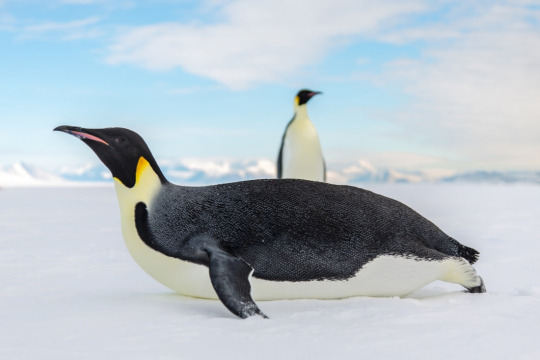
(image id: an emperor penguin lying belly-down on ice, seen from the side. Its back, wings, and head are black while its belly and neck are white. It has a patch of orange feathers near the ears. Another penguin is standing up in the background. end id)
Aptenodytes forsteri is the largest of all penguins and the sixth largest (by weight) bird in the world, only surpassed by the emu and two species each of the cassowary and ostrich. Those are all paleognaths, one of two living groups of birds, making the emperor penguin the largest of the other group: the neognaths. There are some discrepancies on their size due to the standards of bird measurement, but recent measurements list their standing height as reaching 120 cm (3.9 ft) with a weight of 22.7 to 45.4 kg (50 to 100 lbs). Their weight varies a lot during their lives, with both males and females losing a lot of weight during breeding season. Males generally weigh more than females. Genomic and anatomical analysis indicates that the emperor penguin, along with the closely-related king penguin and an extinct species, are part of a group of penguins that branched off of the family tree before the other living penguin species. As with other penguin species, they are heavily adapted for life in the water. All penguins are flightless, with their wings having adapted into flippers used for swimming. Penguins stand differently than other birds. Most birds have long legs and hold their bodies horizontally to the ground or at an angle, but penguins have short legs and hold their bodies vertically, like humans do. This, plus other adaptations, helps streamline the birds, letting them swim more efficiently. Like other seabirds, their feathers are very dense and coated with oil that repels water. This keeps the feathers from becoming waterlogged, reducing drag and helping keep the bird warm. During molting season, the feathers emerge from the skin mostly formed and push out the old feathers, preventing the penguin from developing bald or thin patched that would compromise insulation. While the feathers are responsible for most of the insulation, a layer of fat also helps. Like other birds, penguins are endothermic, commonly known as warm-blooded. Penguin tongues have backward-pointing barbs that help prevent food from escaping their mouths.
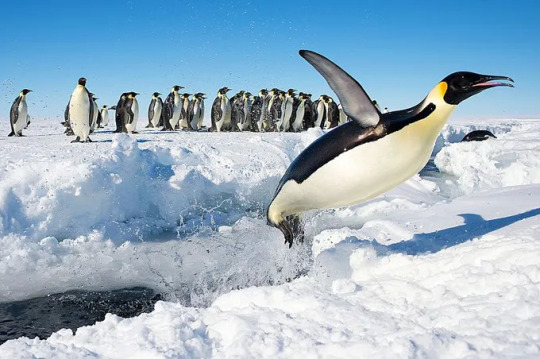
(image id: an emperor penguin jumping out of the water and onto ice. It is pictured in midair with its body roughly parallel to the ground and wings extended. Multiple other penguins are in the background. end id)
Emperor penguin's divide their year between the breeding season and the rest of their lives. During most of the year, they spend their time searching for food. Most of this food consists of fish, krill, and squid. Emperor penguins are social animals that often coordinate with each other to hunt in groups. While hunting, they will dive up to 535 meters (1,755 ft) and spend up to 21 minutes underwater before surfacing to breathe. During dives, the pressure can increase up to 40 times and the emperor penguin has some special adaptations to cope. Unlike most birds, emperor penguin bones are solid, reducing the chance of one breaking under pressure. During dives, the heartbeat slows dramatically and non-essential organs cease functioning to conserve oxygen in the blood. In addition, the hemoglobin in the red blood cells is modified to carry more oxygen in high pressure and low temperature. While on land, emperor penguins gather in colonies along the shoreline. Members of the colonies spend a lot of them time huddled against each other to keep warm. The penguins live all around Antarctica between 66 and 77 degrees southern latitude.
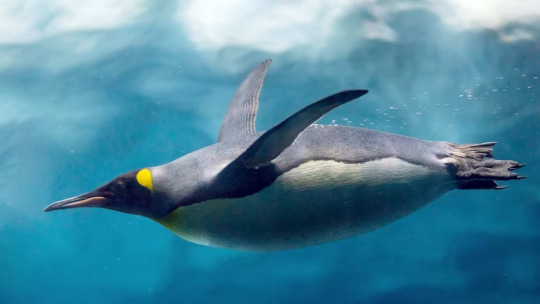
(image: an emperor penguin swimming underwater. Its head is pointed up, making its body very streamlines. Its wings are extended and are used for propulsion and steering. end id)
The thing emperor penguins are most famous for is their breeding behavior. Breeding season starts at the beginning of winter in Antarctica, between March and April, and is triggered by the decrease in day length. Penguin colonies travel inland en masse moving between 50 and 120 km (31 to 75 miles) to find a spot to raise their chicks. These spots are usually large, flat patches of sea or lake ice with a barrier such as a cliff or iceberg used to block the wind. Males perform sexual displays wherein they make loud courtship calls while wandering around the colony. When a female is interested, she will face they male and they will both hold their heads up for a few minutes. Once a pair os formed, they will walk around the colony together. When ready to mate, The pair will bow to each other. Emperor penguins are serially monogamous. They will only mate with one other penguin each season, but rarely pick the same mate more than once. The pair say together until the egg is laid in late May or early June. The female then transfers the egg (only one is laid every year) to the male, a tricky process. They have to use their feet to transfer the egg without dropping it. If the egg breaks or is exposed to the ice for more than a minute or so, it will die. It is not uncommon for an egg to be lost, especially in first-time parents. If this happens, both parents will leave the colony and return to the sea, not mating again until next year. The male balances the egg on his feet and covers it with a loose flap of skin. The bottom of this skin is a featherless patch called the brood patch that only forms during this season. By keeping the egg between his feet and the brood patch, the male incubates it. Once the egg is transferred, the female returns to the sea, leaving the male responsible for the next few months. In every other penguin species, the mother and father take turns incubating their egg. for the next 65-75 days, the male will incubate the egg in the middle of the Antarctic winter, where storms are frequent and temperatures can can reach into the -60s C (-70s F). He will not eat at all during this period, which, including travel and mating time, can last for 120 days. Males can lose up to half of their body mass during this fast. If the egg is dropped even once, it has a very high chance of dying. Walking without dropping the egg is tricky, but the males will form tight bunches to conserve body heat. These bunches are mobile, with members to the outside gradually moving inward and vice-versa. The egg usually hatches after around 60 days and it can take a few days to break out of its shell, which is thicker than in most bird species. The chicks are born featherless and will freeze to death if they leave the male's brood pouch. The male produces a substance called crop milk with a gland in his esophagus. Crop milk is unique to pigeons, flamingos, and male emperor penguins and is used to feed the chick. The crop milk does not provide full nourishment to the chick, but will keep it alive for about a week.
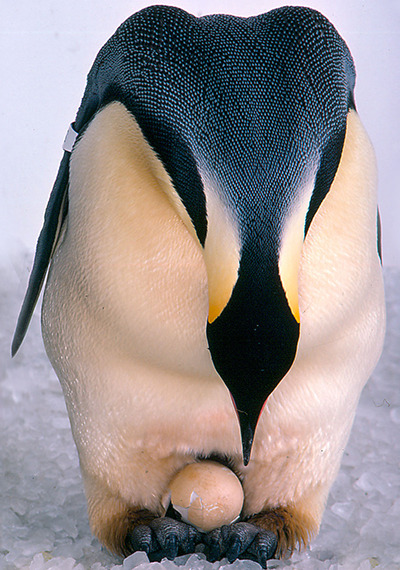
(image id: a male emperor penguin standing on ice with its egg balanced on its feet. The skin flap thet normally covers the egg is pulled back and the male is bending over to examine the egg. This egg is broken, possibly the result of being dropped, and is non-viable. end id)

(image id: a newly-hatched emperor penguin sitting on it's father's feet. It is very small and featherless, with grey skin and a black head. end id)
About this time, the female will return from her time at sea. She spent this time feeding and fattening herself up for the next leg of the parenting journey. She returns to the colony usually between 5 and 10 days after the hatching. If she arrives too late, the chick will starve. Once she arrives, she will locate her mate through the sound of his calls. The male then transfers the chick to the female's brood pouch and returns to the sea to feed and put weight on for another 3-4 weeks. The female will feed the chick by regurgitating half-digested food into its mouth. After this, the mother and father will take turns brooding the chick and feeding at sea. If either parent is delayed or dies, the chick will die as the remaining parent will eventually abandon it and return to sea. Orphaned chicks will try to seek food and shelter from other adults and mothers who have lost a chick may try to adopt an abandoned one, but as a single parent cannot raise a chick alone, it will eventually be abandoned as the adult goes to feed. Sometimes, a mother who lost her chick will attempt to steal a chick from another mother. This leads to fights over chicks that may leave chick trampled to death.
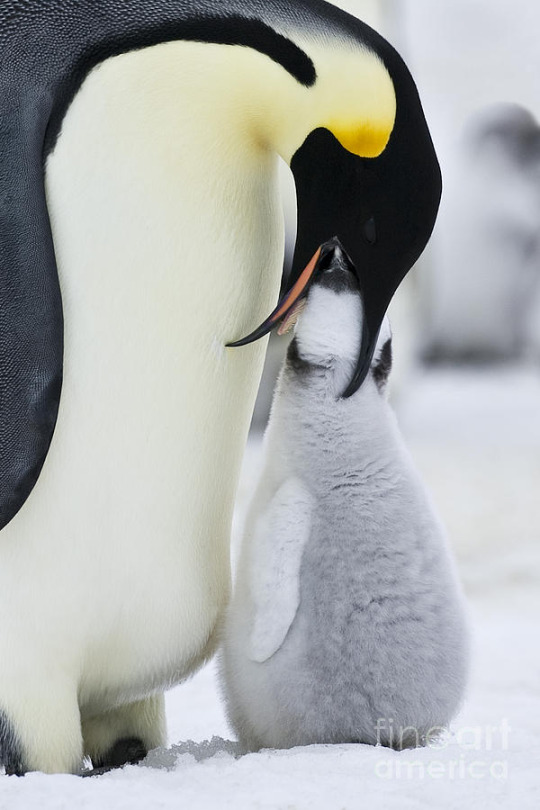
(image id: an adult emperor penguin feeding its chick. The chick is larger and covered in fluffy, grey, downy feathers. It no longer needs to stay on its parent's feet. The adult is looking down at the chick with its mouth open. The chick has its head inside the adult's mouth. end id)
Starting 45-50 days after hatching, the chicks now have a thick enough coat of down to survive outside of the brood pouch. Starting around this time, both parents will return to the sea and occasionally return to bring food, using the sound of their chick's vocalizations to track them down. When the parents are gone, the chick huddle together for warmth. Starting in early November, the chicks will start gaining their adult plumage and the adults will stop returning to feed them. Once they get hungry enough, the chicks will make the trip to the sea (which is shorter now as it is summer in the Antarctic and the sea ice has receded) and will be independent from now on. Only 15% of chicks survive their first year, but after that the survival rate is 95%, meaning most living emperor penguins are adults. Emperor penguins reach sexual maturity at 3 years, but most do not mate until they are 4-6 years old. The average lifespan of those who live long enough to reach adulthood is 20 years, but may live up to 50 years. The high survival rate of adults is in part due to a lack of predators. Adult emperor penguins are only hunted by leopard seals and orcas, though the former prefer juveniles. Juveniles are preyed upon by seals when they reach the water and by southern great petrels when on the ice. Adult emperor penguins lack any land predators, which has resulted in them having no prey response when on land. Scientists and antarctic explorers have reported that adults will approach them without fear.
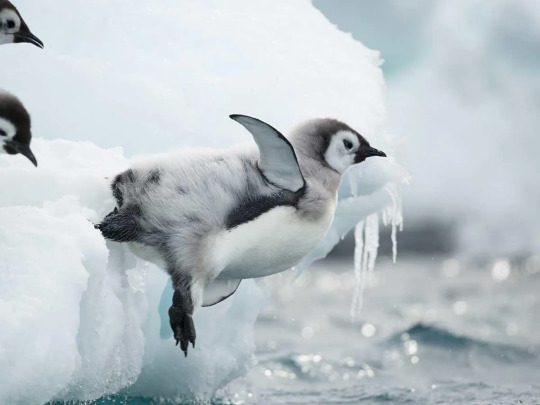
(image id: a newly-independent chick entering the water for the first time. It has not yet fully developed its adult plumage and has a mix of the chick's fluffy down and an adult's smoother coat. It is jumping off a ledge of ice into the water. Two other chicks watch from the side of the image. end id)
Emperor penguins are classified as near threatened by the IUCN, meaning they are losing population and may slip down into threatened status if conservation measures are not taken. The largest threat to emperor penguins is global warming reducing their habitat. Because they need sea ice to lay eggs and brood, the loss of sea ice every year has reduced the ability of the penguins to reproduce. in 2022, loss of sea ice led to a catastrophic failure to reproduce among nearly all known colonies. It is now estimated that 90% of colonies are at risk of dying out due to the loss of sea ice. If these trends are not reverted by reduction of global warming, the penguins could face extinction.

(Image id: two emperor penguins with their chick. The adults are standing behind the chick, which has its downy juvenile plumage. The chick stands about half the height of the parents. end id)
#wet beast wednesday#emperor penguin#penguin#marine biology#biology#zoology#ecology#animal facts#marine life#good parenting#cute#image description
123 notes
·
View notes
Text
Thought I had written this idea up before but apparently I didn't. (Because I didn't have much of a plot/set up to jazz it up I suppose?) But I remembered the worldbuilding element again when Shiro on discord was talking about the #Shen Yuan is born as Tywin Lannister's eldest son AU:

Okay so on Earth, the "North" can be referencing Canada, Russia, Scandinavian land and more. It's huge. More importantly, the planet is ROUND (no flat earthers on my timeline thank you very much).
We know one side of Mobei Jun's Northern Empire is Luo Binghe's Southern Demon Empire. What happens when Mobei Jun crosses the North Pole of his territory to the other side of the globe? What lands are those?
Hm... Westeros? >.>
So let's toss it into Shen Yuan is born as Tywin Lannister's eldest son AU. The Shen Qingqiu body died in an explosion and the Sun and Moon seeds (if that's the wrong name, well it's midnight here and I'm sleepy) kind of did its thing but not really and Shen Yuan gets an actual human body... in Joanna Lannister's womb. Maybe she ate some weird new plant that a merchant was introducing to the Westerland lord in hopes of getting a trade deal going with the very wealthy Casterly Rock which SURELY would love exotic plants to eat.
Anyways, this is all to say that Luo Binghe's hunt for his shizun won't have to involve going to other dimensions now. Mobei Jun calls up his demon overlord emperor to help the North solve a growing problem with some weird monsters cropping up in its most remote territory (aka the white walkers). Lo and behold, Luo Binghe learns of another human kingdom.
Plus with this twist to PIDW geography, Cang Qiong can join in the ride and fun of discovering a blonde hair green eyed Shen Qingqiu.
Oh and Jiu-Finger lurking in the back with a little dagger ready to stab Yue Qingyuan of course.
Welcome to live time plotting and editing where various details written in previous posts get chucked out of the window
[More in #Shen Yuan is born as Tywin Lannister's eldest son AU]
#mobei jun#svsss#svsss ideas#svsss au#shen qingqiu#shen yuan#Shen Yuan is born as Tywin Lannister's eldest son AU#scum villain's self saving system#mxtx#game of thrones#tywin lannister#luo binghe
114 notes
·
View notes
Text
Lord Byron’s journal entry for April 19th 1814. He expresses his depression after the Bourbon Restoration:
"April 19. 1814.
There is ice at both poles, north and south — all extremes are the same — misery belongs to the highest and the lowest only, — to the emperor and the beggar, when unsixpenced and unthroned. There is, to be sure, a damned insipid medium — an equinoctial line — no one knows where, except upon maps and measurement.
‘And all our yesterdays have lighted fools
The way to dusty death.'*
I will keep no further journal of that same hesternal torch-light; and, to prevent me from returning, like a dog, to the vomit of memory, I tear out the remaining leaves of this volume, and write, in Ipecacuanha, — ‘that the Bourbons are restored!!!' — 'Hang up philosophy.'** To be sure, I have long despised myself and man, but I never spat in the face of my species before — 'O fool! I shall go mad.'***”
* Macbeth ** Romeo and Juliet *** King Lear
#anti monarchy#lord byron#literature#english literature#dark academia#aesthetic#poetry#romanticism#history#writing#bourbon restoration#bourbon#france#napoleon bonaparte#napoleon#regency#1800s#19th century#shakespeare#diaries#journals#macbeth#romeo and juliet#king lear
33 notes
·
View notes
Text
What my OC would say in Doctor Who: Ninth Doctor
------------------------------------------------------------------------------
*Entering the Nestene lair*
Hydra: Well this looks familiar~
Rose: How, we haven't been here before?
Hydra: No, It just reminds me of my sisters room
Rose: Your sister has chains in her room?
------------------------------------------------------------------------------
Cassandra: I am the last Pure Human
Hydra: HA, yeah sure, tell yourself that if it makes you feel comfortable, you up right trampoline
Rose: Ouch
------------------------------------------------------------------------------
Man: Can't keep them down sir! They walk!
*Nine turns to Hydra"
Nine: Isn't that something you should be angry about because of the balance of life and death?
Hydra: Hey, as long as the souls go into the after life the bodies are up for grabs
------------------------------------------------------------------------------
Harriet Jones: Who's not human?
Rose: They are not human
Harriet Jones: They are not human?
Hydra: I'm not even an Alien
Harriet Jones: What????
------------------------------------------------------------------------------
Guard: Thank you doctor but I think I know how to fight a single tin robot
Hydra: That single tin robot killed 14 of your staff but alright!
------------------------------------------------------------------------------
*Adam Mitchell getting information into his brain and expose The Doctor, Rose and Hydra*
Hydra: OH THAT MEAT BAG IS GETTING EXEECUTED WHEN I'M DONE WITH HIM!
------------------------------------------------------------------------------
Hydra: I have these really cute bats as my pets, though they only appear when someone disrupted the balance of life and death... *looks at Rose with a too wide smile*
------------------------------------------------------------------------------
Little Boy with gas mask: Are you my mummy?
Hydra: I think the universe will have collapsed if I did have children
------------------------------------------------------------------------------
Nine on phone: Slitheen heading north!
Hydra: Yes sir~
*Stretches their arm out and a gust of wind blows the people out of the way and the window pane, jumping out and grabbing onto a pole Bayonetta style*
Hydra: Going down~
*Slides down pole*
------------------------------------------------------------------------------
Dalek Emperor: I am the GOD of ALL Daleks
Hydra: AHAAHAHAHAHAH, oh please, oh great Dalek Emperor!
Hydra: Y̶̡̱̠̹͛̓́͌́͑͆̑̈́̀́̓̉͑̋̅ȏ̸̝̙̻̗͕̮͔̤̮̦͎̳͚̳̆͆̓͌̑͗̆͆͗́̌̀̀̈́͜͜͠͠ų̵̨̨̬̯̮̙̘̘̾́̽̊͂̽̾͂̔̈́͠ ̷̞͍̬̬̗̰͍̫̰͉̐͐̎̈́̿̇̎̍̌̆͘͝ǎ̶̡̨̭̖̫̥̞̩̱͈̤͖̳͇̯̈́̚ͅͅr̶͍͚͔͎̖̻͈̿̇́̾͝ę̵̘̱̝̪̣̭̰̱͓͙̦͚͎̳̞̽̅̄̈́̓͂̊͘̚͝ ̸̼̖̩̗̙͍͓̠̬̺̟̠̈́͠ͅn̶͎̮̋̈̉̍̎̋̐̋̾ớ̵̛͚̩͖̖͉̗̮̱̓̈́̓̓̓̅̐̅͗̈́͂̚͘ť̵̙̗̣͎̮̜̱̣̩̤̤̪̄̉̑̐̑̀͛̋̐̒͒̓̌͠ ̸̡̣̻̘̗̬̝̲̼̪̭͖͇͓͙̾̽̋̈́̇̓̂̀̀̕͠o̴̡̰͉̩̝̜̝̣̫̍̾̕n̶̢͕͇̠̬͈̹̺̜̳̦͈̜̆̇̃ ̸̢̤̠̦͚̀̈́͝O̵̡̗̟̤̰͚̞̤̫̺͔͍͋̍̅́͌͑̿̕̚͜U̴̳͋͋̈́̐̑̓͗̄̔̆́̓̽̒̔̈̑Ŗ̶̱̳̟̺̣̝̯͙̥͕̩̳̙̻̪̾͌͊̊̅̎́̃̃̎̚͘̚̚͠͝͝ ̸̨̢̫͖̱̥̤̲̻͉̣͔̠̲͝ͅL̵̝͌̋͐̌͌̎̚̕Ḛ̶̛̦̦͖̻̠͊̀͘ͅV̸̛̦͒̐̿̔̈́̍͌̌̂͝Ẽ̴̢̧̨̛͔̯̗̹̳̘̼̲̮̿̈́̃̽̿͆͊͛͒ͅĻ̷̥̩̣̤̩̦̠̱͎̹̩̹͖͕̇̀́͆̈́̉̆̀̍̓̾͛
------------------------------------------------------------------------------
*After seeing the Tenth regeneration*
Hydra: Oh hello pretty boy~
Rose: His face is different!
Hydra: Yeah and now we have David Tennant as the Doctor
Rose: Who?!!?
Hydra: No one important
7 notes
·
View notes
Text
ATLA Live Action Thoughts
Well hello there! After letting the events and creative choices of the Live Action ATLA show absorb for about 24 hours after finishing the series, I think it's time to put my thoughts to the page.
Yes, that was a mouthful of a sentence. Sorry about that.
To start things off, I loved it! Did I love every single part? Not exactly, but the creative choices and how everything was weaved together? YES! It felt exactly like a fairly well-put-together fanfiction for me. It incorporated loved pieces of the show while warping them slightly to fit within the creator's vision.
Now, we all like lists right? I know I do, so let's do some listing.
The Good:
The CGI for the fights was pretty well awesome alongside the choreography for the scenes. While some fights lacked a bit of depth (Katara vs Pakku) and certainly could have had more oomph with more length, I can still appreciate them for what they are.
To add to that, the bending looked freaking awesome! The earthbending had a signature ..crunch to it, water flowed, fire was punchy (though had one small bit to be desired - I'll address this later) and air was flighty.
The CGI creatures were great IMO. Momo was a little gremlin, which fits him perfectly. He was still cute in spite of his gremlinosity. Appa - I absolutely loved him. I think he's as good as he could possibly look in the media. He's still a ten-ton flying monstrosity of a bison, and he's perfect. He's fluffy. He's Appa. OSTRITCH HORSES! They were awesome and looked like living dinosaurs - nuff said.
The acting and line delivery, while rougher in the early episodes flourished as each episode went onward and the kids got more comfortable/experienced. You could really tell they were giving it their all, and I applaud them! Awesome work on their part!
Storytelling - the combination of different episode topics together flowed rather well! I really enjoyed them putting together the things they did.
And now for a bit of a read more for spoilers.
The storytelling was rather well done, especially things like adding Omashu, Jet and the freedom fighters, and the Mechanist (as well as the cave of the two lovers) together. Overall, it played well, and I'd like to think it was a good approach NOTE: This is from someone who is actively adapting the series in my own fanfic, and I can see aspects of that approach in the adaptation. I love to see it!
Ozai playing his children against each other is probably one of my favorite aspects of the entire thing! He's a manipulator in this version, which if they were going to have him on-screen rather than the ominous shadow emperor, then I think this was probably the only choice. I loved it.
----------------------------
The not good not bad:
Nudging the story in a darker direction was a choice. I know I just spoke at length about how I liked the creative choices and I'm not sure how I feel about this one. As someone who's throwing a lot of trauma at the characters in his fanfic, It can be a lot. To have that on screen is difficult since it can end up hiding characters' sense of being if not handled correctly.
Katara - in the animated show - always a go-getter, filled with righteous anger, not backing down, and strong-willed Katara - in the live-action show - fairly timid, but slowly growing over time into her strength of will. I wasn't a fan of the vision of Katara early in the season, but by the finale, it was starting to feel like her. (I still wish her fight with Pakku was better)
The family of Aang, Katara, and Sokka - I've seen quite a few posts talking about how they don't feel like a family in the live-action. In the animated show, after rewatching it recently, I feel like they didn't really grow toward a family unit until after the North Pole. They were good friends traveling together. Yes we had the line from the Southern Air Temple of 'We're your family now' but I don't think I truly felt it until season 2. Don't get me wrong, they were close, but I didn't get those true bonded feels until S2.
Iroh felt like Iroh half the time, and the other half, I'm not sure who he felt like, but it wasn't in a bad way? Like, we explored a different part of him. With his first interaction with Aang, we even saw him as the reluctant Fire Nation general. As he still was at that point. I can appreciate the change and don't mind it a ton.
Bumi. I think I've decided that Bumi was where Katara's righteous anger went. He doesn't immediately forgive Aang for disappearing, and then reappearing. Bumi has fought a war for a hundred years and has had to deal with ALL THAT for a hundred years. To say he'd be prickly is an understatement. Honestly? He has no reason to forgive Aang. I don't mind this change - though he could've toned down the dickishness IMO.
Katara's bending progression: In each episode of the show she improved both in skill and strength, when finally she fought Pakku, she used self-developed techniques. Those are the traits of a master bender. While we don't get to see her training with Pakku, or demonstrating that she truly has mastery over the element, we get shown that she has indeed grown immensely. A few extra training scenes would've gone a long way, especially with Aang.
Speaking of Aang. Aang had no water-bending training along the way north :( I would've liked to see that, but it's not a deal-breaker.
--------
The bad/meh- Let me preface this by saying I still love the show. There were a few moments that were lacking though (and one that was meh throughout):
The firebending, while amazing in almost EVERY SINGLE ASPECT, was lacking in one. FIREBLASTS AND FIREBALLS ARE SHOT FROM THE FIST, NOT GATHERED IN YOUR HAND LIKE CHI BLASTS. Sorry.
Katara. Where were your responses in some of those interactions? You sat there and listened (which in some cases is a good thing for someone expressing their emotions) but didn't respond when you could have/should have! I feel like we missed a bit of her character when we lost some of her in those. It's not enough to be a truly detracting piece of the show, but I should say that I wasn't a fan of that choice.
Roku was a bit...too unserious. He was the serious avatar in ATLA (in terms of brooding and wanting to help guide Aang.) He...got the Bumi jokes. That was an odd choice. I hope they revisit him in the future and he is able to redeem that aspect.
At the end, during the scene at the North where Aang gives himself over to the ocean spirit, I didn't really like the idea that the avatar was lost to the spirit. I also didn't like the "I need you" from Katara. Not from a shipping perspective, but from a character perspective. In the animated show, Katara spent a lot of effort showing that Aang is her hope for a better world. In the live-action, that wasn't there, so that line seemed out of place.
Hmm, four negative points. I'm sure there were more, but none are springing to mind at the moment, so perhaps I'll edit this later.
----------------
Final thoughts.
I need to stress that the likeability of the show hinges heavily on how you approach it. If you approached the live-action hoping for a perfect retelling of the ATLA story, then you are going to be severely disappointed. If you instead approach it for what it is - an adaptation of the story, with nudges events in one way or another, and includes new approaches, then you'll love it. I went in expecting a fanfiction type of show, and I think I got more than expected. The kids gave this thing their all, and it shows! Everyone showed improvement through the episodes and by the end really fell into their roles.
I certainly hope the future has another (2) season(s) lined up because I'd love to see what twists and turns we're in for.
Oh yeah, and scarf. I liked the scarf scene. There is no shipping bait in Omashu.
#atla#geotheraider writes#avatar the last airbender#natla review#natla positive#natla spoilers#zuko#katara#aang#sokka
25 notes
·
View notes
Text
Today’s random ocean fact: all penguins live in the southern hemisphere!
I saw someone in the replies of my last penguin fact ask for another penguin fact, so let’s talk about them! All 18 penguin species live south of the equator. They range from South America (with Magellanic penguins like the one photo below), to Africa (with the aptly named African penguins), to Australia (with the blue penguins mentioned in my earlier post) to Antarctica (with the iconic emperor penguins). So if you’re having trouble remembering the differences between the north and south poles remember- only the south pole has penguins!

[Photo ID: A black-and-white Magellanic swimming on the surface of bright blue water.]
#I’m happy to talk about whatever people want to hear about so just let me know if you’re curious about something!#education#marine biology#ocean#science#trivia#fun facts#random facts#antarctica#birds#penguins#magellanic penguin
6 notes
·
View notes
Text
GANYMEDE

The largest and most important of the Gallilean moons. Continents of ice floating above an unfathomably deep sea, a thin and cold atmosphere barely clinging to its surface. Sprawling tundra of squamous lichens and icy shores piled high with red kelp. So distant from the sun, the dim light of the sky and the soft glare of Jupiter can provide only enough light and heat to sustain a paltry assemblage of primitive flora across most of the world, which in turn supports a meager assortment of radial-beaked rabbits and hexaped moose. At the poles, however, the situation changes. Unlike every other moon in the entire solar system, Ganymede has a magnetosphere, and this electric dynamo produces, when combined with the intense radiation of the jovian belt, a 24/7 aurora borealis, green and blue light dancing across the sky. There, the ecosystem is more advanced, transitioning from tundra and muskeg to scrubland, rolling hills, and, in a hundred-mile basin resting near the north pole, Ganymede’s only forest, an unknown land shrouded beneath the canopies of its towering pines.

The aboriginal people of Ganymede are the Lah-cyg, who look something like two swans sewn together back-to-back, using their twin necks to sling spears, row oars, and perform all the rest of the manipulations humans use hands for. They stand about as tall as men, but, adapted to Ganymede’s low gravity and evolved treading over thin ice and boggy ground, are considerably lighter and weaker. They’re a culturally diverse species, having spread across Ganymede millennia ago and formed into many now distinct peoples, from the canoe whalers of the southern sea to the bobsled-hunters of the deep tundra to the leshy-emperors of the great forest. Though their anatomy is alien, psychologically and behaviorally they are very near-human, even if they communicate as much with their eight flag-wings as their voices and their natural lifespan is near five hundred years.

Ganymede was already under an extraterrestrial yoke when the tsan-chan first arrived. The Garzbhel amphibians, polypous frog things either convergent on or distantly related to the moon beasts of luna, had, from their europan homeward, descended on Ganymede along with the rest of the jovian system, flying across the void of space on the backs of their slave-steeds, the xeno-pegasi known as the Oxarith. From their forts and feitorias of gelatinous stone, they meddled with the affairs of the Lah-cyg, demanding slaves, their compradors and tributaries among the ganymedians given access to their trumpet-spiraled guns to aid in the slave-raids. Ganymede was ravaged by slave-wars, the losers stuffed in cages and hauled across the void to toil and die beneath Europa, the winners given more guns and ammo to capture ore slaves. It was in this context that the Tsan-Chan arrived. The Garzbhel would not bend the knee, and so the Tsan-Chan beat them back to Europa. It was a brief war, Garzbhel void-chariots against Tsan-Chan torchships like roman triremes against 21st-century aircraft carriers - the Garzbhel retreated to the wine-dark seas beneath Europa, collapsed the ice-shafts behind them, and have not emerged in force since. The only ones seen now are the few guerrilla holdouts left hiding out in the uncharted wilds, and the scant few who submitted to Tsan-Chan conquest. The mere passing of the Garzbhel would have been enough to throw their accomplices, the warrior-kindoms which grew wealthy off the slave trade, into turmoil - the Tsan-chan did not even give them that chance. Those old kingdoms are now subjects of the cruel empire, and the entire moon is claimed as a possession by the tsan-chan - though, the control is more tenuous in reality than on paper. Ganymede is the largest moon in the solar system, and much of its vastness remains untouched by human hands (though not by lah-cyg beaks).

The Tsan-Chan, unlike the Garzbhel, do not come to Ganymede seeking slaves. Nor do they come seeking furs, or moss, or ice. From Ganymede they want only one thing - fish. The Tsan-Chan have raised on Ganymede a series of sea-ports, little bays with raised walls and guns on towers, but really the seat of their occupation is their only Gaynmedian city - Nuevo Francisco. The entire city is built and devoted to processing as much fish as possible, gutting, canning, and launching into orbit to provide the rest of the empire with cheap protein from the Gallilean sea. It reeks, of course, of salt and blood and brine - noisy, too, the grinding of the factory-machines, the rumbling of the ship-engines, the constant motion of the task.

The ice-trawlers that feed Nuevo Francisco dredge far and wide and deep, smashing through the delicate ecosystems perched on the iceberg-shelf. These are not the chief target, though - the native species too clever and wild and balanced in appetite and growth for the Tsan-Chan use. What they seek is fish in the true sense, not just the Ganymedian analogues. Hatchery towers spill into Nuevo Francisco’s bay, their insides churning with millions and billions of fry, bred in tanks, genelines broken and spliced and chained to maximize speed of growth, monstrous things as artificial as the ships which catch them.

Of course this monstrous industry has had wide-ranging impacts at every step of the process. The Lah-cyg of Ganymede’s coasts are impacted, of course, whether pushed off the seas directly to make room for Tsan-Chan ships, or indirectly by the competition, mauled by the malformed jaws of the hyperagressive terran frankenfish or poisoned by their unnatural flesh. So to is the natural life - anything in the path of the dredge-nets, is annihilated utterly, but the impact extends beyond the reach of ice-trawlers and their piscine quarry. Many of the species who rest on Ganymede’s icy shares dive for their food, and so the ravaging of the coastline has threatened them, and with them all the parasites and predators who attack them on land - the loss of this quarry driving starving carnivores inland, with it’s own knock-on effects. Even the fauna of the void above have suffered, the vacuum-pelicans which once dove for fish coming up more and more with empty beaks, and without the nutrients of their dung the high mountains and dead comets on which they nest struggle to survive. Ganymede’s seas are deep beyond measure, and the neritic zone which man has touched barely a fraction of it’s true extent, yet the easy life of the starlit waters is vital to the life of much of what lives below, but unlike land and sky the depths of Ganymede’s seas are truly unknown… few can even dream of what stirs below.

things I couldn’t figure out how to fit in the post:
Nuevo Francisco, and the tsan-chanese on ganymede more broadly, are by-and-large deep one hybrids - actually part of the reason why they stock the seas with earth-fish, because their abilities to call fish into nets don’t work on alien species.. there’s no full-blooded deep ones though because the true deep ones are on tenuous terms with the tsan-chan anyways and are frankly just not well-suited to the long transit to Jupiter, being enormous and requiring lots of space and water.. confinement in a metal can barely their own size for several months would be nearly unsurvivable
As always, the impacts of colonization has driven many Lah-cyg into the city to try and find work because their traditional lifestyle has been made impossible.. mostly been relegated to domestic work, wiping windows, scrubbing floors, peeling potatoes, etc -
Lah-Cyg essentially stone age because there’s no metals to work, best they can really get is good rocks from the gravel of the rocks embedded in some parts of the ice but they mostly work with bone and leather.. tundra and muskeg and stuff makes for poor agricultural soil, a few peoples in especially fertile regions able to get by with chinampas but by and large everyone’s either a fisher, hunter, or herder.. canoes mostly inuit-style umiak.. “Leshy-Emperors”, the people of the great northern forest, wealthiest, most advanced and last really independent Lah-Cyg state due to monopoly over wood trade granting historical wealth and in modern times cover of the forest shielding from Garzbhel and Tsan-Chan invasion
Mi-Go presence on Ganymede is very, very limited - a few emmisaries have been sent to try and torment rebellion among the Lah-Cyg but the lack of both mineral resources not buried under a million miles of uncharted water and much in the way of men of learning to brain-can means they care little for the moon itself
something something black citadel city of the billion-year past spawn of yuggoth, architecture similar to the prison-temple of ghatnoathao, inside a brother-god of ghatnothoa and rhan-tegoth but a dead one.. medusa-motifs dictate that chryasaor-style thing stalks inside, sea foams with horrid-flapping things that emerge from the sea-foam and fly off into space.. this original birthplace of the Oxarith pegasi, who instinctually fear it knowing that it would destroy them to know their own origins
Ganymede in the dream is a solid shell of ice, no seas no nothing, with enormous chains wrapping across the entire planet.. dreamers wander its surface shivering and freezing. . strange groaning beneath the ice
this is because the entire planet is a prison for horrible elder-gods held at it’s core, confined beneath the deepest ocean in the solar-system under countless layers of ice.. as secure as can be, great cthulu only gets one ocean on top of him instead of like five.. secure in the dream, where they’re awake, less so in the waking world where the ice is cracked
#worldbuilding#lovecraft space opera/tsan-chan buck rogers#I promise I'll get to gameable stuff eventually maybe#stuff some tables in or some shit#blogpost
9 notes
·
View notes
Text
Fishman island arc thoughts
Just finished fishman arc and here are some ramblings

important episodes for the one piece Lore : 569, 570
concepts that i think would be relevant later on as i keep watching the rest of the arcs :
Joyboy (Neptune says The ship Noah was supposed to have some connection with joyboy, who lived during the 100 year blank gap in history, around 800 years ago, [epi 569])
the true purpose of Noah the ship and who did the sea kings refer to when they said they need that person's help to repair it?
Robin saying the fishman island having poneglyph that contains content from the 100 year blank gap in history
Luffy being able to hear the sea kings (just like Roger was able to)
Some questions I've been pondering about that might be relevant as i go through the rest of the series but might be absolute circus shoes :

Luffy & Shirahoshi : Shirahoshi is the queen of the sea kings and there was a legend that a man will come and help her unlock her ability to communicate with the sea kings (which Luffy did). And they form a good friendship. So is the joyboy and the mermaid princess story like a foreshadowing of the bond between Luffy and shirahoshi?
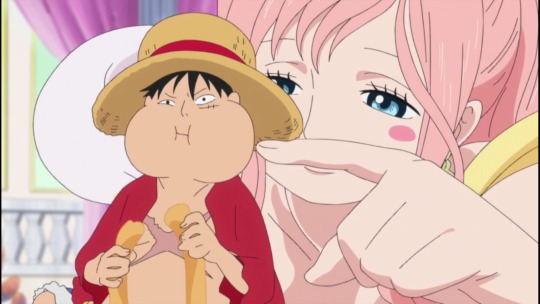
Noah and the fishmen : there is a shot of noah the ship with otohime's grave. i wonder if noah the ship, has any connection with being a bridge in the whole humans and fishmen friendship development (like how otohime was)
Kraken : Surume (kraken) is a mythological creature brought from the North pole by hordy and it was said that surume has a brother there. I wonder if we'll get to see surume or that brother in the future.
Uranus : so there are 3 ancient weapons, Pluton, Poseidon, and Uranus. Pluton is a ship made in Water 7, Poseidon is a mermaid (Shirahoshi) from the fishman island, and uranus is still unknown (up until fishman arc). Since the weapon named Poseidon (shirahoshi) is related to the sea like the original god was, will Uranus have any relation with sky/weather/skypiea like the original greek god uranus?
Things I'm looking forward to :
fuck akainu he is a rotten bastard anyway I'm excited to see what aokiji would do now, since he seemed to have 0.2 ounces of morals and decorum with how he has handled Robin twice (in Ohara when she was a kid and during the water 7 party).
The introduction to another of the yonkos/4 emperors is interesting. Big mom sounds like a psychward patient, is shanks the only normal one among the 4 yonkos? Big mom is a cannibal with stomach acid for saliva????? and she has a daughter(?)/sister(?)/person in her court(?) with 3 fucking eyes?
luffy's jolly roger is getting the reputation of being able to claim a territory? OMG my babygirl im so proud of him. Would love to see him becoming more of a badbitch claiming territories
Luffy keeping his promise to shirahoshi to take her to a stroll in a forest above the sea was cute and would love to see it.
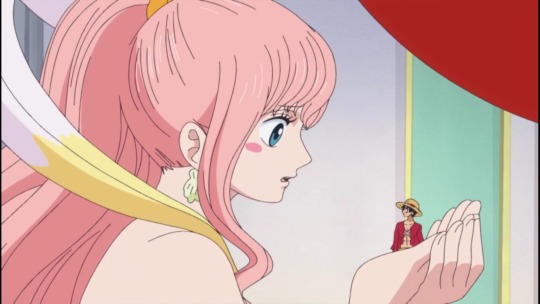
Luffy's outfit game has really changed during this season, let's see what happens in the future
Let's go punk hazard!
#logging my experience and thoughts with each arc like im a pirate logging my adventures in grandline omg#anyway will be starting punk hazard soon#op arc thoughts#op thoughts#one piece#fishman island arc#fishman island
8 notes
·
View notes
Text
Chapter 18: What a Swine!
-A few pages into the chapter, and I found the first hook to go on a giant tangent: according to Gao Cai, Gao Village is located in the Kingdom of Qoco. I have no idea why Yu translated it as such, since the original Chinese name——Wusi Zang(乌斯藏, a transliteration of dbus gtsang) sounds nothing like that, but in short, it's the Ming dynasty name for Tibet.

-However, a quick glance at this map would show you that the real Xuanzang didn't cross Tibet during his journey; rather, he went the long way around the Himalayas, travelling on the Central Asian Silk Road. In the Ming dynasty, if you wanna go to India, you could actually take the route through the Himalayas and Nepal, but it wasn't there in the Tang dynasty (because there were a couple of hostile kingdoms in the way; Tuyuhun, Tubo, etc.)
-Sidenote, I absolutely love how JTTW '86 adapted this chapter, with SWK getting his flirt on and the legendary "Pigsy Carrying His Bride" sequence that had made its way into many subsequence adaptations.

-JTTW Research had written pretty comprehensively about Pigsy's origins, from the Daoist deity Marshal Canopy to his ties with Marici, an import deity with a boar mount who's also associated with the Dipper Constellation. As such, I only had one tidbit to add about possible inspirations for his character in folklore that predated the above.
-The earliest tale about a lusty pig demon could be found in the Tang dynasty Xuan Guai Lu(玄怪录). Guo Yuanzhen, a historical general during the reign of Gaozong and Wu Zetian, came across a mansion in his youth during travel. The whole place was lavishly decorated, as if preparing for a wedding banquet, but eeriely empty save for one crying woman.
-Turned out, she was the unwitting soon-to-be bride of a god called "General Wu"(乌将军), who demanded a beauty as his wife every year from the locals, and because they would pay a hefty sum to "buy" said bride, her own father sold her out to be this year's sacrifice. Furious, Guo disguised himself as a guest, pretended to offer General Wu some venison, then cut off his hand with the meat knife.
-Wounded, the General fled, and his severed limb turned into a pig's hoof once the sun came out. Soon, the bride's family and village elders came to the manor, ready to collect her body for the funeral, and were so freaked out by what Guo did that they were ready to sacrifice him to General Wu too, since the "god" was known to summon storm and hails whenever he didn't get his bride.
-Guo scolded them for being so damn guillible because no real gods would demand human sacrifices or, y'know, have pig hooves as hands, before gathering the young men of the villages and following the trail of blood to the pig demon's abode, where they proceeded to smoke it out and kill it with an assortment of arrows and farming tools.
-The woman, after calling out her terrible parents, pledged herself to Guo and became one of his wives, and all was well.
-Honestly, Pigsy's evolution from his folklore origins to JTTW Zaju to JTTW novel seemed to be one in which he became increasingly sympathetic; from basically being a more lusty version of Guanyin's goldfish, to an opportunistic kidnapper who took advantage of a pair of star-crossed lovers' family feud, to an ex-deity turned reformed demon who kinda got screwed over by his in-laws.
-Final note: Pigsy bragged that even if they could get the "Monster-Routing Patriarch" to come down from the Nine Heaven and exorcise him, he could still claim to be an old buddy of the guy. Which…wasn't wrong, considering that "Monster-Routing Patriarch" was the title of Emperor Zhenwu, Lord of the North, who was worshipped alongside Marshal Canopy as one of the Four Saints of the North Pole.
@journeythroughjourneytothewest
67 notes
·
View notes
Text
Losers Round 2, Match 13: Zane Julien (Lego Ninjago) vs. Paku (Avatar: The Last Airbender)


Zane Propaganda:
zane julien is the white/titanium ninja and master of ice! he has died the most out of all the ninjas, but it's fine, he always gets better :) once he went mad for a season because of time travel shenanigens, became an emperor, and killed an entire group of people (and then canon just forgot). we've never had a proper zane season which is A CRYING SHAME. oh yeah and he's a robot! and he can cook! you're really not going to vote for a character who can cook? for shame.
Paku Propaganda:
hes a waterbending master of the north pole and also a massive asshole. hes an ice queen bc he got his heart broken in his youth by his arranged marriage fiance leaving him for the south pole
#battleoftheicyfreaks#tournament#lego ninjago#ninjago#zane julien#avatar the last airbender#paku atla
63 notes
·
View notes